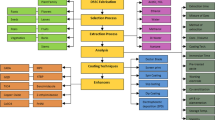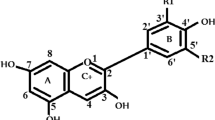Abstract
A new photosensitizer 1-WS55 (dyad) based on two dyes with excellent properties, azulenocyanine (1) and WS55, is proposed at the density functional theory level (M06/def2-SVP). 1 is a dye having a broad NIR absorption (~ 1000 nm), and WS55 is a metal-free organic dye that presents a huge photoelectric conversion efficiency (PCE) of 9.5%. The dyad presents a panchromatic absorption along the UV–Vis-NIR region. It exhibits two intense Q bands (880, 926 nm) in the NIR region, one strong band (672 nm) in the visible region, and several bands in 300–600 nm. Charge transfer bands in the dyad from 1 to WS55 were found in the visible region, which favors the adsorption on an anatase TiO2 surface. The interaction energies dyad (dye)-TiO2 were calculated as a periodic system and corrected by the basis set superposition error. These show better adsorption for the dyad than fragments 1 and WS55. The electron injection calculated from the dye (dyad) to TiO2 suggests an efficient solar energy conversion because of ΔGinj > 0.2 eV. Additionally, calculations performed for the reorganization energy of electrons and holes indicate that the dyad presents the highest charge mobility. In summary, the dyad proposed 1-WS55 constitutes an excellent candidate to be used as a potential photosensitizer for the DSSCs.
Graphical abstract







Similar content being viewed by others
Data availability
N/A.
References
O’Regan B, Grätzel M (1991) A low-cost, high-efficiency solar cell based on dye-sensitized colloidal TiO2 films. Nature 353(6346):737–740
Hagfeldt A, Boschloo G, Sun L, Kloo L, Pettersson H (2010) Dye-sensitized solar cells. Chem Rev 110(11):6595–6663
Mishra A, Fischer MKR, Bäuerle P (2009) Metal-free organic dyes for dye-sensitized solar cells: from structure: property relationships to design rules. Angew Chen Int Ed 48(14):2474–2499
Rao RS, Suman SSP (2020) Near-infrared (>1000 nm) light-harvesters: design, synthesis and applications. Chem Eur J 26(70):16582–16593
Zatsikha YV, Maligaspe E, Purchel AA, Didukh NO, Wang Y, Kovtun YP et al (2015) Tuning electronic structure, redox, and photophysical properties in asymmetric NIR-absorbing organometallic BODIPYs. Inorg Chem 54(16):7915–7928
Wei H, Feng R, Fang Y, Wang L, Chen C, Zhang L et al (2018) The diradical-dication strategy for BODIPY- and porphyrin-based dyes with near-infrared absorption maxima from 1070 to 2040 nm. Chem Eur J 24(72):19341–19347
Xie J, Shi K, Cai K, Zhang D, Wang J-Y, Pei J et al (2016) A NIR dye with high-performance n-type semiconducting properties. Chem Sci 7(1):499–504
Simard TP, Yu JH, Zebrowski-Young JM, Haley NF, Detty MR (2000) Soluble, infrared-absorbing croconate dyes from 2,6-Di-tert-butyl-4-methylchalcogenopyrylium salts. J Org Chem 65(7):2236–2238
Mack J, Kobayashi N (2011) Low symmetry phthalocyanines and their analogues. Chem Rev 111(2):281–321
Muranaka A, Yonehara M, Uchiyama M (2010) Azulenocyanine: a new family of phthalocyanines with intense near-IR absorption. J Am Chem Soc 132(23):7844–7845
Qi D, Zhang L, Zhang Y, Bian Y, Jiang J (2010) Nature of the intense near-IR absorption and unusual broad UV−visible−NIR spectra of azulenocyanines: density functional theory studies. J Phys Chem A 114(51):13411–13417
Ince M, Hausmann A, Martínez-Díaz MV, Guldi DM, Torres T (2012) Non-covalent versus covalent donor–acceptor systems based on near-infrared absorbing azulenocyanines and C60 fullerene derivatives. Chem Comm 48(34):4058–4060
Bottari G, de la Torre G, Guldi DM, Torres T (2021) An exciting twenty-year journey exploring porphyrinoid-based photo- and electro-active systems. Coord Chem Rev 428:213605
Ince M, Bartelmess J, Kiessling D, Dirian K, Martínez-Díaz MV, Torres T et al (2012) Immobilizing NIR absorbing azulenocyanines onto single wall carbon nanotubes—from charge transfer to photovoltaics. Chem Sci 3(5):1472–1480
Muchuweni E, Martincigh BS, Nyamori VO (2020) Recent advances in graphene-based materials for dye-sensitized solar cell fabrication. RSC Adv 10(72):44453–44469
Xie Y, Wu W, Zhu H, Liu J, Zhang W, Tian H et al (2016) Unprecedentedly targeted customization of molecular energy levels with auxiliary-groups in organic solar cell sensitizers. Chem Sci 7(1):544–549
Becke AD (1988) Density-functional exchange-energy approximation with correct asymptotic behavior. Phys Rev A 38(6):3098
Lee C, Yang W, Parr RG (1988) Development of the Colle-Salvetti correlation-energy formula into a functional of the electron density. Phys Rev B 37(2):785
Becke A (1993) Density-functional thermochemistry. III. The role of exact exchange. J Chem Phys 98:5648
Weigend F, Ahlrichs R (2015) Balanced basis sets of split valence, triple zeta valence and quadruple zeta valence quality for H to Rn: design and assessment of accuracy. Phys Chem Chem Phys 7(18):3297–3305
Weigend F (2006) Accurate Coulomb-fitting basis sets for H to Rn. Phys Chem Chem Phys 8(9):1057–1065
Frisch MJ, Trucks GW, Schlegel HB, Scuseria GE, Robb MA, Cheeseman JR, et al. Gaussian 09, Revision D.01. Wallingford CT2009
Zhao Y, Truhlar DG (2008) The M06 suite of density functionals for main group thermochemistry, thermochemical kinetics, noncovalent interactions, excited states, and transition elements: two new functionals and systematic testing of four M06 functionals and 12 other functionals. Theor Chem Acc 119(5):525
Cárdenas-Jirón G, Figueroa Y, Kumar N, Seminario JM (2016) Doping effects in the charge transport of graphene–porphyrins. J Chem Phys C 120(4):2013–2026
Cárdenas-Jirón G, Borges-Martínez M, Sikorski E, Baruah T (2017) Excited states of light-harvesting systems based on fullerene/graphene oxide and porphyrin/smaragdyrin. J Phys Chem C 121(9):4859–4872
Tunç G, Zambrano-Angulo M, Arslan BS, Güzel E, Nebioğlu M, Ahsen V et al (2021) Insight into the effects of the anchoring groups on the photovoltaic performance of unsymmetrical phthalocyanine based dye-sensitized solar cells. Dalton Trans 50(8):2981–2996
Barone V, Cossi M (1998) Quantum calculation of molecular energies and energy gradients in solution by a conductor solvent model. J Phys Chem A 102(11):1995–2001
Cossi M, Rega N, Scalmani G, Barone V (2003) Energies, structures, and electronic properties of molecules in solution with the C-PCM solvation model. J Comput Chem 24(6):669–681
Quantum ATK Q-2021.06, Synopsys Quantum ATK (https://www.synopsys.com/silicon/quantumatk.html)
Harmandar K, Granados-Tavera K, Gezgin M, Nebioğlu M, Şişman İ, Cárdenas-Jirón G et al (2022) A new sterically hindered asymmetric zinc phthalocyanine as an efficient sensitizer for dye-sensitized solar cells. New J Chem 46(2):714–725
Tirado-Rives J, Jorgensen WL (2008) Performance of B3LYP density functional methods for a large set of organic molecules. J Chem Theor Comput 4(2):297–306
Muranaka A, Uchiyama M (2021) Development of phthalocyanine-based functional molecules with tunable optical and chiroptical properties. Bull Chem Soc Jpn 94(3):872–878
Estrella LL, Balanay MP, Kim DH (2016) The effect of donor group rigidification on the electronic and optical properties of arylamine-based metal-free dyes for dye-sensitized solar cells: a computational study. J Phys Chem A 120(29):5917–5927
Hagfeldt A, Graetzel M (1995) Light-induced redox reactions in nanocrystalline systems. Chem Rev 95(1):49–68
Mosurkal R, He J-A, Yang K, Samuelson LA, Kumar J (2004) Organic photosensitizers with catechol groups for dye-sensitized photovoltaics. J Photochem Photobiol A: Chem 168(3):191–196
Pastore M, Fantacci S, De Angelis F (2013) Modeling excited states and alignment of energy levels in dye-sensitized solar cells: successes, failures, and challenges. J Phys Chem C 117(8):3685–3700
Wang J, Li H, Ma N-N, Yan L-K, Su Z-M (2013) Theoretical studies on organoimido-substituted hexamolybdates dyes for dye-sensitized solar cells (DSSC). Dyes Pigm 99(2):440–446
Xu Z, Li Y, Zhang W, Yuan S, Hao L, Xu T et al (2019) DFT/TD-DFT study of novel T shaped phenothiazine-based organic dyes for dye-sensitized solar cells applications. Spectrochim Acta A Mol Biomol Spectrosc 212:272–280
Xu Z, Lu X, Li Y, Wei S (2020) Theoretical analysis on heteroleptic Cu(I)-based complexes for dye-sensitized solar cells: effect of anchors on electronic structure, spectrum, excitation, and intramolecular and interfacial electron transfer. Molecules 25(16):3681
Mahmood A, Tahir MH, Irfan A, Al-Sehemi AG, Al-Assiri MS (2015) Heterocyclic azo dyes for dye sensitized solar cells: a quantum chemical study. Comput Theor Chem 1066:94–99
Farhat A, Yaqoob A, Khera RA, Riaz MU, Anjum FA, Langer P et al (2021) Designing and theoretical characterization of benzodithiophene dione based donor molecules for small molecule organic solar cells. Optik 242:167098
Mehboob MY, Hussain R, Adnan M, Irshad Z (2021) End-capped molecular engineering of S-shaped hepta-ring-containing fullerene-free acceptor molecules with remarkable photovoltaic characteristics for highly efficient organic solar cells. Energy Technol 9(5):2001090
Rasool A, Zahid S, Shehzad RA, Akhter MS, Iqbal J (2021) Designing of benzodithiophene (BDT) based non-fullerene small molecules with favorable optoelectronic properties for proficient organic solar cells. Comput Theor Chem 1203:113359
Tozini D, Forti M, Gargano P, Alonso PR, Rubiolo GH (2015) Charge difference calculation in Fe/Fe3O4 interfaces from DFT results. Procedia Mater Sci 9:612–618
Rajbanshi B, Kar M, Sarkar P, Sarkar P (2017) Phosphorene quantum dot-fullerene nanocomposites for solar energy conversion: an unexplored inorganic-organic nanohybrid with novel photovoltaic properties. Chem Phys Lett 685:16–22
Lu T, Chen F (2012) Multiwfn: a multifunctional wavefunction analyzer. J Comput Chem 33(5):580–592
Kumar NS, Rao LS (2022) Theoretical insights into interaction energy, IR intensity and Raman activity enhancements of H2O adsorbed on Mg containing Zn3O3 nanoclusters: A computational study. Comput Theor Chem 113708
Munir M, Ahsan F, Yar M, Ayub K (2022) Theoretical investigation of double-cubed polycationic cluster (Sb7Se8Cl2) 3+ for the storage of helium and neon. Mater Sci Semicond 148:106756
Sattar N, Sajid H, Tabassum S, Ayub K, Mahmood T, Gilani MA (2022) Potential sensing of toxic chemical warfare agents (CWAs) by twisted nanographenes: a first principle approach. Sci Total Environ 824:153858
Funding
We thank the financial support of ANID/Chile under Projects FONDECYT 1221072 (G. C.-J.), FONDECYT 1180565 (X. Z.), and FONDAP 15110019 (Y. H.-R.). It is grateful for the support of ANID/Chile by Program/Doctorado Becas Nacionales 2021/21210406 (M.Z.-A) and 2021/21210404 (K. G.-T.). Powered@NLHPC: This research was partially supported by the supercomputing infrastructure of the NLHPC (ECM-02) of the Universidad de Chile.
Author information
Authors and Affiliations
Contributions
Kevin Granados-Tavera: original draft, methodology, formal analysis.
Michael Zambrano-Angulo: original draft, methodology, formal analysis.
Yoan Hidalgo-Rosa: original draft, formal analysis.
Ximena Zarate: original draft, formal analysis.
Gloria Cárdenas-Jirón: Project administration, review and editing, methodology.
Corresponding author
Ethics declarations
Conflict of interest
The authors declare no competing interests.
Additional information
Publisher's note
Springer Nature remains neutral with regard to jurisdictional claims in published maps and institutional affiliations.
This paper belongs to Topical Collection XXI—Brazilian Symposium of Theoretical Chemistry (SBQT2021).
Rights and permissions
Springer Nature or its licensor holds exclusive rights to this article under a publishing agreement with the author(s) or other rightsholder(s); author self-archiving of the accepted manuscript version of this article is solely governed by the terms of such publishing agreement and applicable law.
About this article
Cite this article
Granados-Tavera, K., Zambrano-Angulo, M., Hidalgo-Rosa, Y. et al. Tuning the visible-NIR absorption of azulenocyanine-based photosensitizers. J Mol Model 28, 344 (2022). https://doi.org/10.1007/s00894-022-05329-y
Received:
Accepted:
Published:
DOI: https://doi.org/10.1007/s00894-022-05329-y




